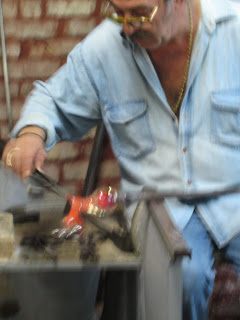
Photo: Louise Bourgeois, Arch of Hysteria, 2000.Courtesy, Galerie Karsten Greve, Köln, Paris, Milano, St Moritz and Cheim &Read, New York. Photo: Christopher Burke
A late tribute to Louise Bourgeois who exhibited aged 71 in New York died end of May aged 96 and was working within days of her death. That gives hope to all us late starters, apart from the extraordinary quality of her work dealing mainly with women's experience through their bodies. 'The Arch of Hysteria' (photo above) as you can see is made out of fabric. I chose this version rather than the bronze and steel sculpture of the same title she made in 1973, since I saw this at an exhibition of her work called 'A Stitch in Time' at the Fruitmarket Gallery, Edinbury in May 2004 and to me, fabric speaks much more expressively of women's work. Is it an arch of pain or orgasm? I like the ambiguity.
Her giant spider might be more well-known but it says very little to me - it is just a spider (whatever the title 'Maman' might suggest of a mother as a weaver/seamstress who repairs and protects but is also inescapable and maybe devouring). The sculpture itself does not make me feel that. Whereas her fabric sculptures have something visceral and tactile and get under my skin too. Incidentally Bourgeois' fabric work has influenced Tracey Emin's work with similar effects.





 the Casa Goldoni -
the Casa Goldoni - 
